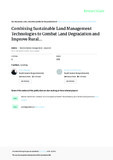| dc.description.abstract | Drylands occupy more than 80 % of Kenya’s total land mass and contribute immensely to the national economy and society through agriculture, livestock production, tourism, and wild product harvesting. Dryland ecosystems are areas of high climate variability making them vulnerable to the threats of land degradation. Consequently, agropastoralists inhabiting these ecosystems develop mechanisms and technologies to cope with the impacts of climate variability. This study is aimed to; (1) determine what agropastoralists inhabiting a semi-arid ecosystem in Kenya attribute to be the causes and indicators of land degradation, (2) document sustainable land management (SLM) technologies being undertaken to combat land degradation, and (3) identify the factors that influence the choice of these SLM technologies. Vegetation change from preferred indigenous forage grass species to woody vegetation was cited as the main indicator of land degradation. Land degradation was attributed to recurrent droughts and low amounts of rainfall, overgrazing, and unsustainable harvesting of trees for fuelwood production. However, despite the challenges posed by climate variability and recurrent droughts, the local community is engaging in simple SLM technologies including grass reseeding, rainwater harvesting and soil conservation, and dryland agroforestry as a holistic approach combating land
degradation and improving their rural livelihoods. The choice of these SLM technologies was mainly driven by their additional benefits to combating land degradation. In conclusion, promoting such simple SLM technologies can help reverse the land degradation trend, improve agricultural production, food security including access to food, and subsequently improve livelihoods of communities inhabiting dryland ecosystems | en_US |

